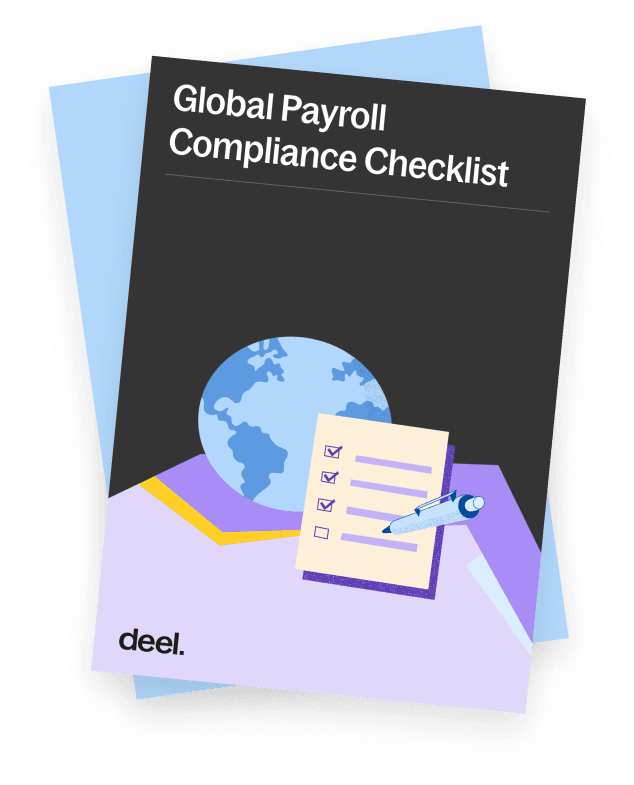Article
9 min read
6 Payroll Questions to Ask When Developing a Global Payroll Strategy
Global payroll

Author
Joanne Lee
Last Update
August 19, 2025

Table of Contents
1. What is the current state of your global payroll?
2. Is your current global payroll strategy scalable?
3. What does your ideal global payroll setup look like?
4. What are some opportunities for improvement?
5. What are your potential barriers to success?
6. Do you have the right support?
Streamline your global payroll process with Deel
Key takeaways
- To optimize global payroll, businesses must proactively assess their current setup, address challenges like changing regulations and manual processes, and clearly define their ideal operational state.
- Evaluating the scalability of your global payroll is crucial for growth, requiring an assessment of workflow integrations, automation, processes, audit readiness, and team capacity.
- Deel enables businesses to manage and scale global payroll operations in 100+ countries, all from a unified platform.
As companies expand globally, many find themselves struggling to keep up with rapidly changing regulations, manual data entry, and disparate HR systems that put compliance and scalability at risk.
In this blog, we’ll walk through the main questions every business should address when evaluating their current global payroll setup. We’ll also share insightful resources for future-proofing your operations and ensuring compliance across borders.
By asking the right questions and making strategic decisions, you can eliminate costly inefficiencies, boost team capacity, and position your business for seamless international growth.
1. What is the current state of your global payroll?
The first payroll question focuses on evaluating your current payroll state. Look at what is working and what isn’t. If you can understand your current strengths, challenges, and gaps, you can use that to inform your global payroll strategy.
A common challenge for global companies is keeping up with varying tax laws and regulations across multiple countries. For example, pay transparency regulations in Brazil require companies with over 100 employees to publish biannual salary data with details about job title, gender, and employee representation to comply with equal pay law. According to regulations in the EU, independent contractors receive access to the same benefits as permanent employees.
And those are just two examples of regulations that are specific to different countries. Partnering with a global payroll provider can help you stay ahead of these changes with automated payroll compliance software and access to local payroll experts.
Here are some additional questions to help you drill down on your current state.
- How many countries do you currently operate in?
- Do you use a centralized or decentralized payroll process?
- Are you outsourcing part or all of your payroll?
- Have you paid compliance fines this year or last year?
- What is your current level of risk?

2. Is your current global payroll strategy scalable?
Growth is always a primary goal in business—more output, increased cost savings, bigger profits. That means your current payroll process is only working to your advantage if it can accommodate growth.
If expanding to another country requires long hours of auditing or especially tedious work, you’re likely facing challenges with scalability.
When evaluating how scalable your global payroll is (or isn’t), consider the following factors.
- Workflow integrations: If you’re constantly jumping between multiple platforms to perform payroll tasks, you may want to consider switching to a unified platform that integrates your preferred tools and centralizes data in one place
- Level of automation: Does your team rely on manual, time-consuming processes, or do you have payroll automations in place to expedite repetitive tasks like calculating deductions and creating payslips? If automation is a primary area you’d like to improve in, consider real-time payroll processing to complete gross-to-net calculations instantly and catch errors faster
- Inconsistencies in payroll and HR processes: Map out your current payroll and HR processes to identify inconsistencies and areas for improvement. This will help you identify specific pain points that you need to address, and it will give you clarity on the features you need in a global payroll solution
- Audit readiness: Consider your current processes for managing payroll documents and data. Are your documents organized, and are you maintaining compliance? If you’re unsure of the answer, this may be a top priority for your business to address
- Team capacity: Realistically, does your current payroll and HR staff have the capacity to run global payroll? If your current team’s bandwidth is low, payroll outsourcing helps reduce compliance risks, streamline payroll processes, and ensure accuracy
3. What does your ideal global payroll setup look like?
Every business does things differently. You can look at industry benchmarks and best practices all day long. But at the end of the day, it comes down to what works for your unique business, market, and goals.
Decide what your ideal payroll setup looks like in the context of your business goals. Do you want to improve scalability and growth? Are you focused on minimizing compliance risks? Or are you aiming to increase operational efficiency and AI automations?
Get as specific as possible about your ideal payroll state to guide your efforts along the way.
Free course
4. What are some opportunities for improvement?
If your current payroll processes are working, make sure you understand why. Whether you decide to switch payroll providers or stay with your current processes, your decision should be backed by strategy, not because the current system feels familiar.
Here are some payroll questions to help you identify opportunities for improvement:
- What is your global growth strategy, and how does your current payroll process support or hinder it?
- To what extent are current payroll processes standardized across countries?
- Do you have a centralized view of global payroll data and costs?
- How easy is it for employees to access their payroll information? How effectively do you resolve employee payroll inquiries across all regions?
- How confident are you in your compliance with local laws and regulations in every country you operate in? How do you proactively stay updated on compliance changes?
As your business grows, there’s always room for improvement. Analyzing these opportunities and making strategic decisions drives your business forward.
5. What are your potential barriers to success?
After examining opportunities, it’s equally important to consider potential threats and barriers that could hinder your global payroll operations. Conducting routine strategy sessions can be a great way to define your opportunities, threats, and your roadmap to success.
For example, your current technology may leave operational gaps being filled by time-consuming, manual processes. Finding the right payroll provider is an opportunity for improvement that will eliminate manual processes and build scalability—but new technology is expensive. In this case, one potential barrier to success would be budget constraints that put important improvements on the backburner.
Identify and compile all potential barriers to building a better global payroll system. Then, refer to your overarching business strategy to guide decisions on how to overcome these challenges.
6. Do you have the right support?
Once you’ve formed a solid picture of your current and future state, you can begin considering different global payroll providers that will serve your goals.
Support comes in many forms. The key is figuring out what type of global payroll provider will benefit your strategic payroll plan the most, support your specific needs, and grow with you as your business changes and expands. Evaluate your current payroll provider’s support by considering how they handle escalations, how accessible the account managers are, and whether they provide adequate training and resources.
If you are not currently partnering with a payroll provider, evaluate your in-house team’s capacity and whether additional support is needed to keep global payroll running on a timely and accurate basis.
We have streamlined and automated a typically very heavy administrative process. This frees up time for us to focus on value-creating activities. This solution has made administration much simpler.
—Sandra Jiesel Lindberg,
Chief People Officer, Mynewsdesk
Streamline your global payroll process with Deel
Relying on a global payroll system that’s just good enough isn’t your only option, and asking the right payroll questions is the first step to optimizing your current processes. Deel Payroll consolidates international payroll operations, HR management, and automated compliance monitoring all in one platform, making it easier for your business to operate efficiently and achieve scalability.
Request a demo to discover how our flexible solutions can adapt to your business’s current and future payroll needs.

Joanne Lee is a content marketing professional with 6+ years of experience creating effective social, search, email, and blog content for companies ranging from start-ups to large corporations. She's passionate about finding creative ways to tell a purpose-driven story, staying active at the gym, and diversity and inclusion. At Deel, she specializes in writing about topics related to global payroll.














